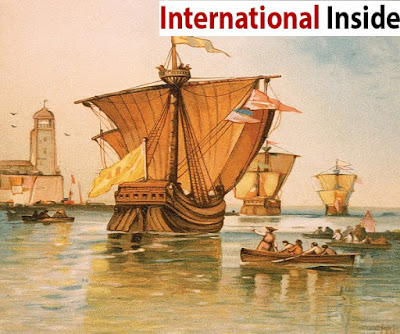Five Facts About Christopher Columbus - International Inside
Christopher
Columbus, the Italian explorer, who sailed
under the auspices of the Spanish court, remains a controversial figure to this
day.
Here are five facts about this fascinating man.
Fact #1 –
Christopher Columbus was not his real name
Scholars are unsure of precisely the year
in which Columbus was born, and both 1450 and 1451 are acceptable. He was born
in Genoa to a wool merchant and his wife and named Cristoforo Colombo. The name
Christopher Columbus is an Anglicized version of his proper name.
Fact #2 – He
wrongly calculated the distance between the Canary Islands and Japan
Columbus was determined to find a safe
westward passage between Europe and Japan. He knew the earth was a sphere, and
he calculated the distance between the Canary Islands and Japan to be
approximately 2,300 miles.
He used his calculations to approach
several governments to fund an expedition to find this westward passage. Still,
many of his contemporaries disagreed with his calculations. They determined the
distance from the Canary Islands to Japan to be in the region of 12,200 miles,
based on the centuries-old estimate that the circumference of the earth was 25,000
miles. This was the reason that
This was the reason that the Portuguese
court, Genoa, Venice, and the English courts all rejected his plan. His
expedition seemed doomed until he persuaded the Spanish court to fund the
expedition for him.
Fact #3 – He
did not discover America
It is a common myth that Christopher
Columbus discovered America. Still, it is not true as that accolade belongs to
Leif Eriksson, a Viking trader who landed in what is now known as Newfoundland
five centuries before Columbus left Spain. Many scholars believe Irish sailors
also crossed the Atlantic centuries before Columbus arrived.
Columbus led four expeditions between 1492
and 1503 and did not land on the North American continent. He had arrived in
the Caribbean Islands around Cuba, the Bahamas, and Hispaniola, and he also
made landfall in Central and South America. Hispaniola is the island that is
now shared between Haiti and the Dominican Republic.
Fact #4 – He
firmly believed he had reached Asia
The entire basis for his expeditions was
not to find a new continent but to sail westwards to Asia. In the late-1400’s,
the route to the lucrative spice and silk trade with Asia was a long and
challenging voyage. It was impossible to travel overland to Asia as there were
many hostile armies in the way, so the only choice was to sail around the Cape
of Good Hope.
Fact #5 – He
was not rewarded for his discoveries
After his first expedition, the Spanish
court was very impressed with Columbus, and he was richly rewarded, but by the
end of his last expedition, he was returned to Spain in shackles and stripped
of all his titles. This was as a result of his and his brothers, appalling and
harsh treatment of the native peoples.
Columbus will always remain a controversial
figure, but one fact that is irrefutable is that his expeditions had a
significant impact on history. Today, the Columbia Exchange is the name given
to the process, started by Columbus, of exchanging plants, animals, and culture
from one part of the globe to another.
Sadly, another result of this exchange is
disease. Native peoples of the Americas had no resistance to European diseases,
and many populations were utterly destroyed by diseases such as smallpox, thus
denying the world any hope of understanding these vibrant cultures.
In spite of all this, Columbus
remains a larger-than-life figure and a courageous explorer.




Comments
Post a Comment